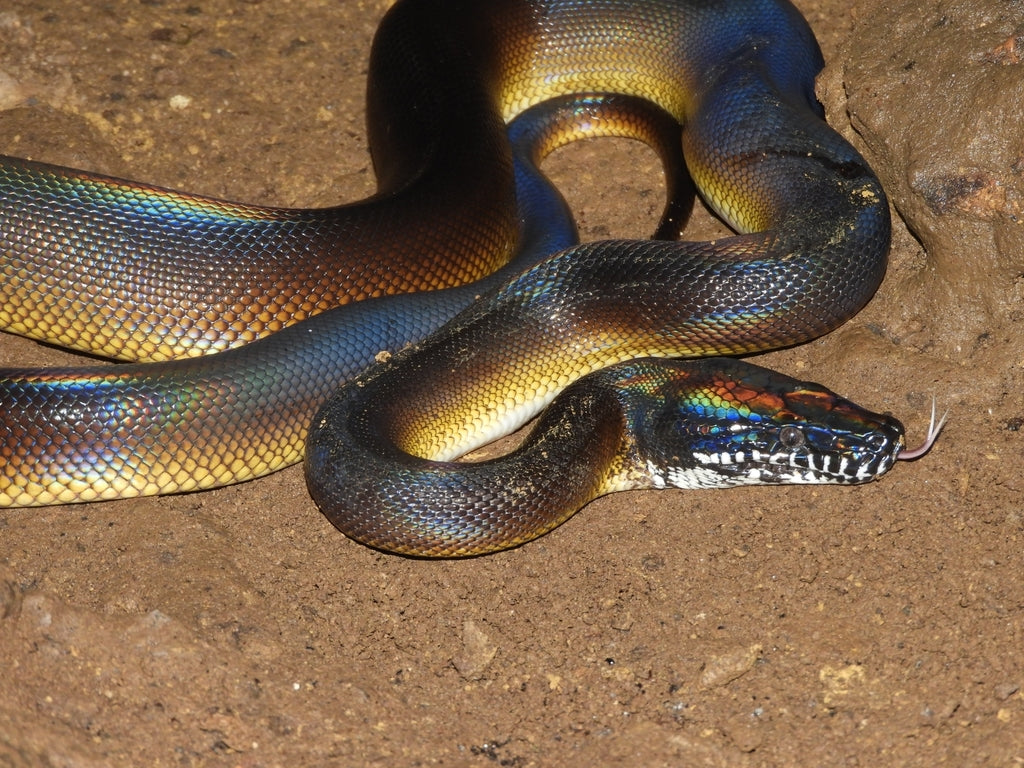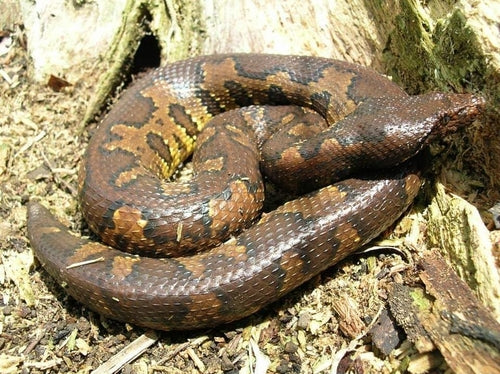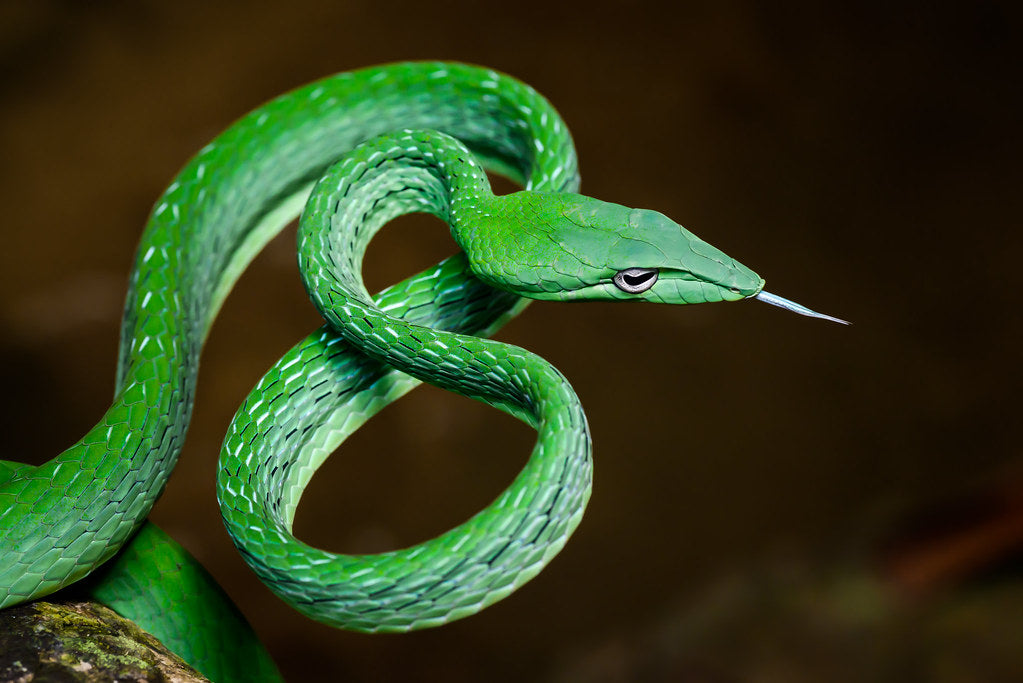White-lipped pythons (Leiopython albertisii) are medium-large, semi-arboreal, nocturnal snakes native to northern New Guinea. They prefer a forested habitat, often close to a body of water.
White-lipped pythons grow to 5-7’ long, with a slender but robust body, rectangular head, vertical pupils, and heat pits on the upper and lower jaws. Coloring is dark brown on top, golden on the sides, and white underneath. The head is black with gray eyes, a white lower jaw, and alternating black and white stripes on the lips. But what really makes this species stand out is its stunning iridescence in sunlight.
Although white-lipped pythons have something of a fearsome reputation, they can make vibrant pets for advanced-level keepers who know how to care for them properly. Temperament and lifespan are likely to be optimized when the animal is captive-bred rather than a wild-caught import.
How much space do white-lipped pythons need?
White-lipped pythons are extremely active snakes, and need plenty of room to stretch out and explore. Given their maximum adult size and semi-arboreal nature, the minimum appropriate enclosure for a white-lipped python must measure 7’L x 3’W x 4’H. This is, of course, just the minimum, and larger is likely to be both appreciated and well used. For the snake’s comfort, this enclosure should be front-opening and have opaque sides.
Cohabitation (keeping multiple white-lipped pythons in one enclosure) is not recommended, as this is not a social species.
Do white-lipped pythons need UVB?
White-lipped pythons are capable of surviving without access to UVB lighting, but it’s still best practice to provide UVB to promote optimal health and wellbeing. UVB gives reptiles all of the vitamin D that their bodies need, stimulates better appetite and activity, and generally allows them to be healthier than they would be without.
Here are the best UVB bulbs and their appropriate basking distances for white-lipped pythons:
- Zoo Med Reptisun T5 HO 5.0 — 9-11” (mesh), 12-14” (no mesh)
- Arcadia Forest 6% — 9-11” (mesh), 12-14” (no mesh)
The UVB bulb should be roughly half the length of the enclosure and housed in a reflective fixture such as Arcadia or Vivarium Electronics, and placed close to the heat lamp on the warm side of the enclosure. Make sure that the fixture your UVB bulb is in does not have a clear plastic or glass bulb cover, as these materials block UVB. UVB lighting also decays over time, so make sure to replace your bulb every 12 months to maintain its performance.
Due to their equatorial origin, white-lipped pythons should receive roughly 12 hours of light year-round.
What basking temperatures do white-lipped pythons need?
Like other reptiles, white-lipped pythons are ectotherms, which means that they need a temperature gradient in their enclosure to help them regulate their metabolism and stay healthy.
White-lipped pythons should have a basking air temperature between 88-92°F, down to 75-82°F on the cool side. It is very important that they have ample opportunity to escape the heat, or else they will get stressed. Temperatures should be measured with digital probe thermometers.
Provide heat for your white-lipped python by imitating the sun with a cluster of at least 2-4 low-wattage halogen heat bulbs on one side of the enclosure. This should create an area of gentle heat large enough to evenly heat the snake’s entire body when coiled. Do not use colored bulbs, as these are not as effective. If temps get too high, dim the bulbs with a plug-in lamp dimmer or proportional thermostat. If temps are too low, you need higher-wattage bulbs.
Light-based heating should be turned off at night. However, the ambient temperature should not get below 75°F at night, so if you need to boost nighttime temps, use a heat mat, ceramic heat emitter, or radiant heat panel connected to a thermostat. These lightless heat sources may also be necessary for maintaining appropriately high ambient temperatures during the day in such a large enclosure.
What humidity levels do white-lipped pythons need?
White-lipped pythons are very susceptible to dehydration and need an environment that is humid, but not soggy. Ambient humidity levels should stay between 55-85%. This can be tracked with a digital probe hygrometers placed in the middle of the enclosure.
Misting your snake’s enclosure with a sprayer every evening and again in the morning (if needed) will help create the right humidity levels. If you need more, using a cool-mist humidifier connected to a hygrostat at night will be helpful. To protect your snake from dehydration, it’s also good practice to provide a humid hide for your snake, lined with moistened sphagnum moss. The substrate should be moist, but not sopping or muddy.
What substrate is good for white-lipped pythons?
White-lipped pythons require a thick layer of moisture-retentive substrate to cushion their bodies and help maintain healthy humidity levels. As an added perk, it also tends to make the enclosure more attractive.
We recommend the following substrates for white-lipped pythons:
Adding a thick layer of clean, chemical-free leaf litter on top of the substrate can also help with humidity and provides additional cover to help your snake feel secure in its environment.
Substrate should be at least 4” deep and completely replaced every 3-4 months. Remove poop and urates daily, along with contaminated substrate.
What décor can you use in a white-lipped python terrarium?
It’s terribly stressful for a snake to be stuck in an enclosure with nothing in it, especially for one as active and inquisitive as the white-lipped python. It doesn’t matter how big the enclosure is if you don’t put things in it for your pet to use and interact with!
At absolute minimum, you will need to provide a sturdy climbing branch and a couple of hiding places for the snake. However, it’s best practice to go well beyond the minimum. Here are some ideas of things that you can include in your white lipped python’s setup for its entertainment and wellbeing:
Due to the size of this snake, all climbing materials must be well anchored to the sides and/or floor of the enclosure to prevent collapse and potential injury.
What do white-lipped pythons eat?
Like other snakes, white-lipped pythons are carnivores, which means that they need to eat whole animal prey in order to get the nutrition that they need. They have slow metabolisms and are prone to obesity, so it’s important not to feed them too much or too often. Here is a basic feeding schedule to get you started:
- Hatchlings — every 7-10 days
- Juveniles — every 10-14 days
- Adults — every 14-21 days
Prey items should be around 10% of your snake’s weight and/or roughly the same width as the snake’s body at its widest point. Although live prey can be used, it’s safest and most humane to use frozen instead. Prey should be thawed in a plastic bag in warm water to approximately 100-105°F before offering with a pair of soft-tipped tweezers.
Remember, the key to great nutrition is variety! Aside from offering mice and rats, quail, chicks, hamsters, gerbils, guinea pigs, and young rabbits can also be used to create variety in your white-lipped python’s diet.
Supplements
White-lipped pythons can survive without vitamin or mineral supplements, but occasionally using them can help prevent nutritional deficiencies and optimize your snake’s health. We recommend Repashy Calcium Plus LoD.
Water
Your white-lipped python should have access to clean, fresh water at all times. They aren’t known to soak, so the water bowl doesn’t need to be particularly large — just large enough to help augment humidity and provide a consistent source of water. Change the water whenever it gets dirty and scrub the bowl with a reptile-safe disinfectant weekly.
Additional Notes
Something to be aware of with white-lipped pythons is that they occasionally cough up furballs, like cats. This is extremely alarming to new keepers who don’t know about this behavior, but nothing to worry about.
Do white-lipped pythons like to be handled?
Few reptiles actually “like” to be held, and white-lipped pythons in particular have a reputation for being defensive and nippy. However, this reputation mostly applies to stressed and/or wild-caught white-lipped pythons, and captive-bred individuals are likely to be easier to tame. That being said, it’s best not to handle this species regularly, and they’re likely to be happier as a display animal.
However, here are some basic rules for handling white-lipped pythons:
- Wait until the snake is eating consistently before introducing yourself.
- Babies and juveniles tend to be more nervous and defensive than adults.
- Be gentle, and pick up the snake from below rather than from above.
- Support as much of its body as possible, and NEVER pick a snake up by its tail!
- Keep handling sessions brief at first, and always end them on a positive note, with the snake acting calm.
*This care sheet contains only very basic information. Although it’s a good introduction, please do further research with high-quality sources to obtain additional information on caring for this species.
“Photo 62352327” by Bagus C. Hermawan licensed under CC BY-NC 4.0




Leave a comment
This site is protected by hCaptcha and the hCaptcha Privacy Policy and Terms of Service apply.